Introduction
In the pursuit of a healthier and more productive workplace, the significance of core workouts cannot be overstated. These workouts not only enhance physical fitness but also play a crucial role in boosting overall well-being, which directly impacts workplace performance.
Among the various methods available, circuit training emerges as a powerful approach, offering a dynamic way to build core strength while keeping participants engaged. By incorporating a variety of exercises into a structured routine, individuals can improve their endurance, stability, and cardiovascular health.
This article delves into the multifaceted benefits of core workouts, provides essential exercises to include in a circuit, and offers practical tips to structure an effective routine. Moreover, it addresses common pitfalls to avoid and highlights the importance of inclusivity in fitness training, ensuring that everyone can participate and thrive.
Embracing these strategies not only fosters a culture of wellness but also empowers teams to achieve their best performance, both physically and professionally.
Understanding Core Workouts: The Benefits of Circuit Training
Core workout circuits are vital for boosting overall fitness and well-being, particularly in the context of workplace productivity. Circuit training stands out as a highly effective method for enhancing foundational strength. By performing a sequence of exercises, participants not only enhance muscle endurance and stability but also elevate their heart rates, significantly contributing to cardiovascular health.
Significantly, the risk of attrition bias and reporting bias was low in all seven RCTs, lending credibility to the effectiveness of essential exercises. Recent findings, such as those from Park, Hyun, and Jee (2016), illustrate that structured instruction can yield remarkable benefits; for instance, a study on semi-professional archers demonstrated significant improvements in balance after just 12 weeks of increased practice volume. Adding fundamental exercises into your routine can result in enhanced stability, improved posture, and a lower likelihood of injury—elements crucial for sustaining high productivity levels at work.
As mentioned by Shengyao Luo, 'core exercises should be regarded as part of athletes’ daily regimens.' This highlights the importance of incorporating a core workout circuit as a regular part of any fitness regimen. Additionally, the versatility of a core workout circuit allows it to be tailored for all fitness levels, making it accessible and suitable for almost everyone.
By embracing the challenge of circuit training, you open the door to transforming your physical capabilities and enhancing your daily performance, creating a healthier and more dynamic work environment.
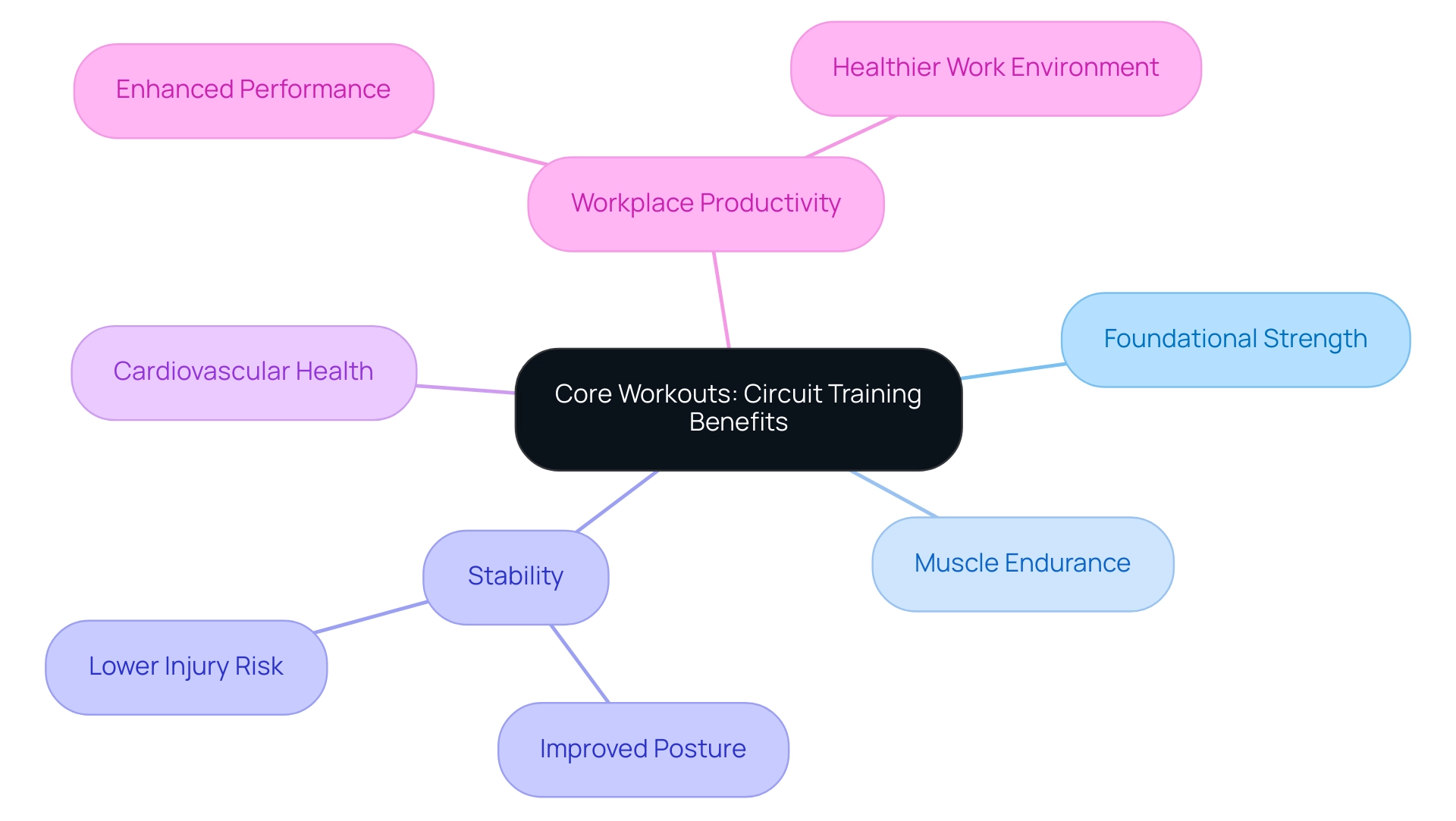
Essential Exercises for Your Core Workout Circuit
To create an impactful core workout circuit, consider incorporating these essential exercises that promise to strengthen and tone your midsection:
- Plank: Aim to hold a plank for 30-60 seconds. This fundamental activity engages your whole midsection, enhancing stability and strength. Studies indicate that movements such as the bird dog can result in notable abdominal muscle engagement, with transversus abdominis (TA) activation measured at 2.63 ± 3.11 mV.
- Russian Twists: While seated, lean back slightly and execute 10-15 repetitions of twisting your torso from side to side. This movement not only works your obliques but also enhances rotational strength vital for daily activities. As mentioned by Tarnanen et al., upper limb activities can effectively engage central muscles, making this activity a valuable addition.
- Bicycle Crunches: Perform 15-20 reps, alternating by bringing your elbow to the opposite knee. This dynamic movement effectively targets multiple abdominal muscles, including the rectus abdominis and obliques.
- Leg Raises: Lying flat on your back, lift your legs to a 90-degree angle and lower them without touching the ground for 10-15 reps. This activity is excellent for the lower abdominal area and enhances overall stability of the body.
- Mountain Climbers: From a plank position, alternate bringing your knees toward your chest for 30 seconds. This high-intensity move not only engages your midsection but also enhances cardiovascular endurance.
Incorporating these activities into your daily routine can significantly enhance the effectiveness of your core workout circuit and overall fitness. A case study titled "Recommendations for Core Workout Circuit" suggests that for optimal results, individuals should incorporate a variety of top-rated exercises into a daily core workout circuit lasting just five minutes, moving away from less effective exercises like traditional crunches. Remember, the focus on proper form and controlled movements is crucial for maximizing effectiveness and preventing injury.
As research suggests, prioritizing these exercises can yield substantial results—so let's focus on the well-being of yourself and your team!
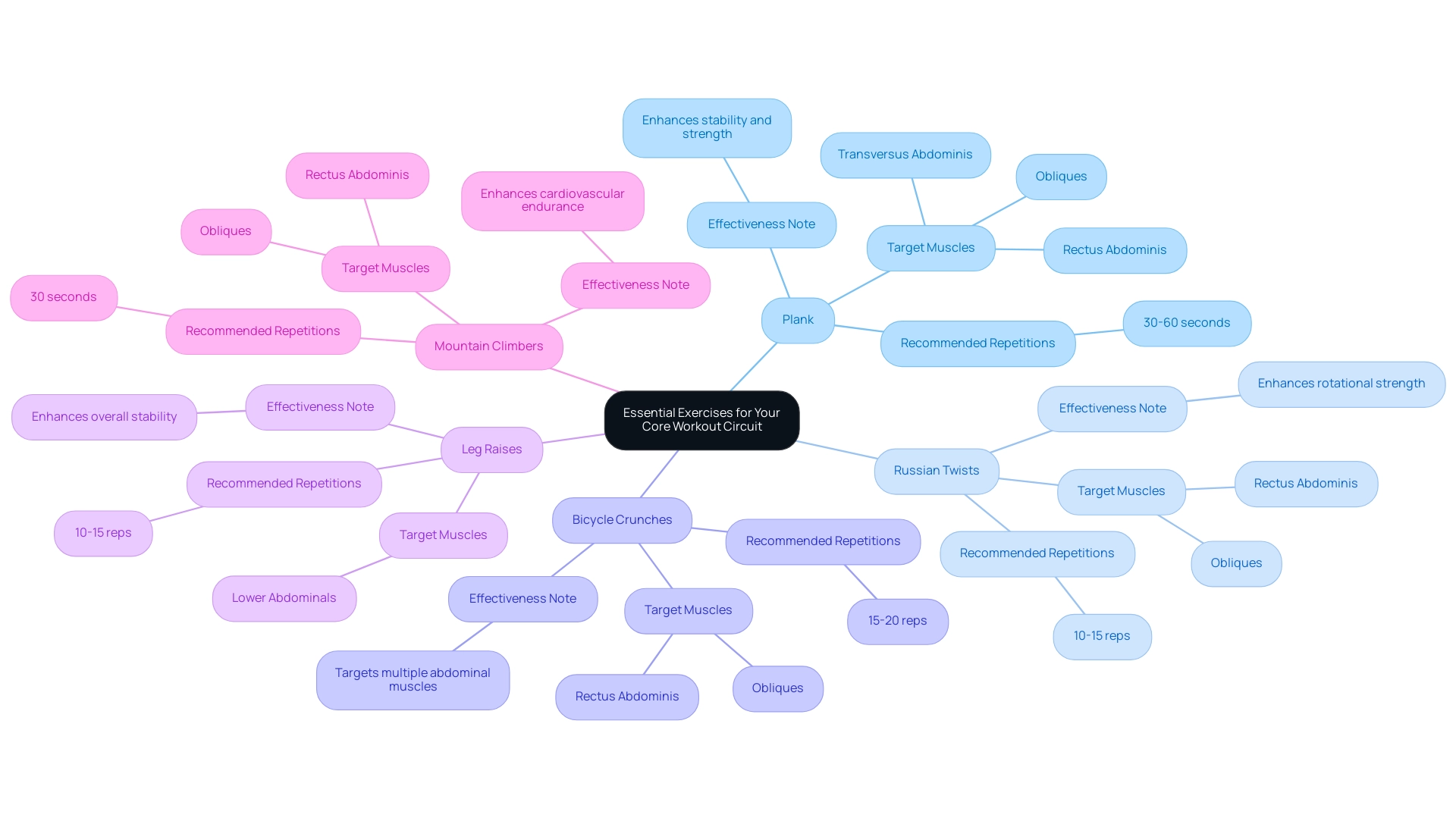
Structuring Your Core Workout Circuit: Tips and Techniques
To create an effective core exercise circuit that inspires both engagement and results, consider the following structured approach:
-
Warm-Up: Dedicate 5-10 minutes to warming up your muscles. This crucial step not only prepares your body for the demands of the exercise but also significantly reduces the risk of injury. As Anthony Grande, a Registered Physiotherapist involved in professional and government organizations to improve care for injury recovery, states,
Whether you’re a seasoned athlete or a fitness newbie, warming up and cooling down should be non-negotiable parts of your workout routine.
-
Select 5-6 Activities: Choose a variety of activities that effectively target different areas of your midsection. Aim for a balanced mix of stability and dynamic movements to ensure comprehensive engagement of your core muscles.
-
Set Time Intervals: Perform each activity for 30-60 seconds, followed by a brief rest period of 15-30 seconds. This interval structure not only maximizes the effectiveness of your training but also aligns with findings from the Subjective Fatigue Scale case study, which noted significant increases in subjective fatigue scores at Post 0 and Post 10 for both high workload (HWU) and moderate workload (MWU) groups. Specifically, subjective fatigue scores were higher than pre-exercise levels, indicating the importance of managing fatigue during workouts.
-
Circuit Repetitions: Complete 2-3 rounds of your circuit, allowing for a 1-2 minute break between rounds. This recovery time is vital for your muscles to regain strength and maintain performance throughout the workout.
-
Cool Down: Conclude your session with stretching exercises. Maintaining static stretches for 15-30 seconds without bouncing improves flexibility and assists in recovery, guaranteeing your muscles are well tended to after the exercise.
By adhering to this organized method, you will not only challenge your core workout circuit effectively but also develop a training regimen that keeps you motivated and engaged, establishing a foundation for long-term fitness success.
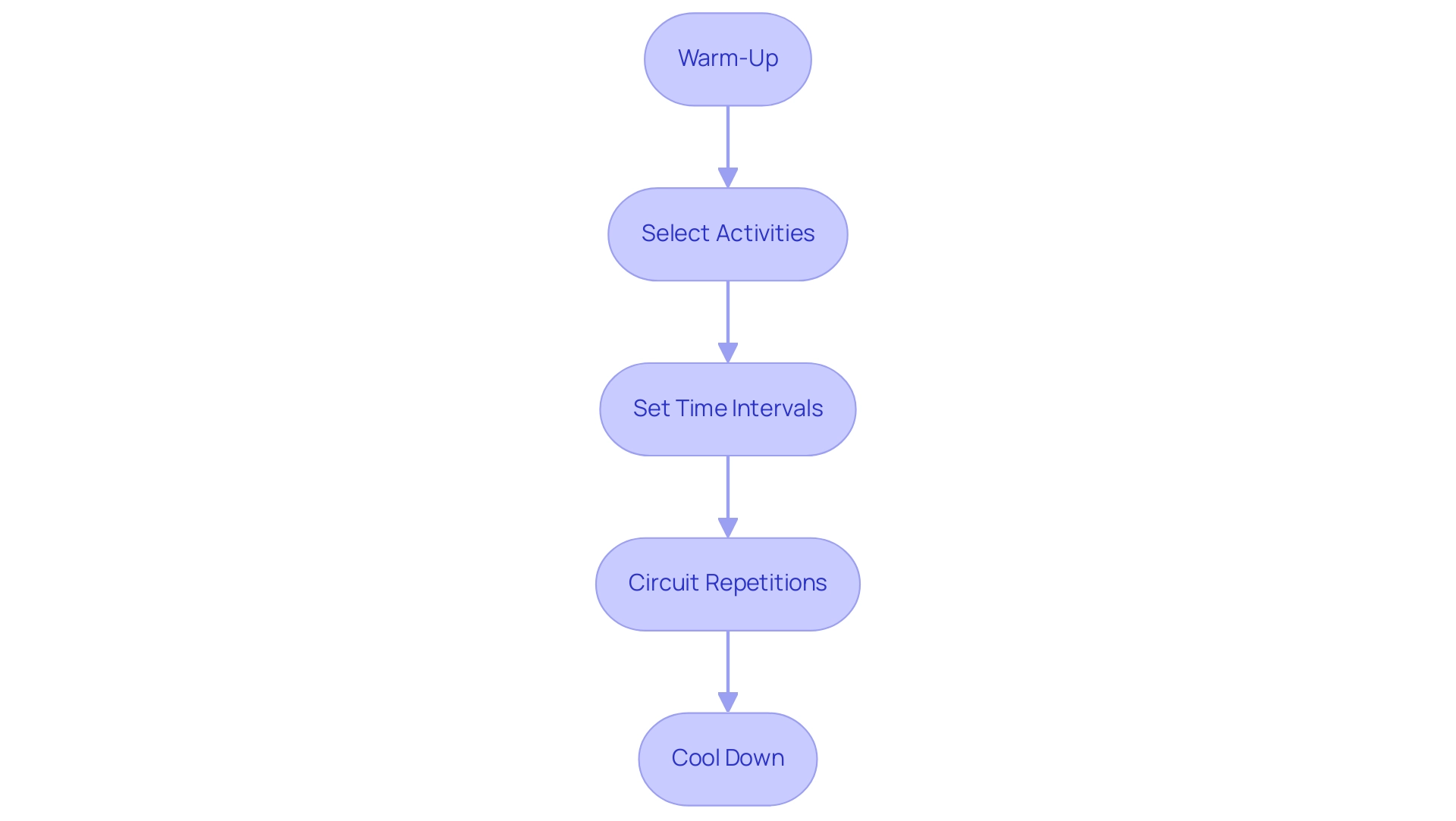
Avoiding Common Pitfalls in Core Circuit Training
When designing your core workout circuit, it's essential to remain vigilant about common pitfalls that can hinder progress and increase the risk of injury. Here are key considerations to keep in mind:
-
Poor Form: Prioritizing proper form is crucial—it's not just about the number of repetitions.
Maintaining correct alignment and technique significantly reduces the risk of injury and enhances workout effectiveness. Fitness professionals stress that a single incorrect movement can lead to long-term setbacks. In fact, statistics show that 61 (15.5%) of participants practicing any sport besides lifting weights reported injuries, underscoring the risks of neglecting form.
-
Neglecting Warm-Up/Cool Down: Skipping warm-up and cool-down routines can result in stiffness and soreness, affecting overall performance. Incorporating these elements primes your muscles for activity and aids in recovery, which is vital for sustained training success.
-
Overtraining: Listening to your body is key.
Overexertion can lead to injuries; therefore, it's imperative to allow adequate rest between sessions. Recovery is not just a luxury—it's a necessity for optimal performance and long-term health.
-
Lack of Variety: Repeating the same activities can lead to boredom and stagnation in progress.
Regularly mixing up your routine keeps you engaged and challenges your body in new ways, which is essential for continuous improvement.
-
Ignoring Modifications: Tailoring exercises to fit your fitness level is crucial.
Alterations guarantee you can execute movements securely and efficiently, lessening the chance of injury while still reaching your fitness objectives.
Furthermore, stability exercises should advance from local muscle engagement to stabilization in different postures, and then to full body dynamic movements. This structured approach is essential for injury prevention and maximizing training effectiveness.
By remaining aware of these pitfalls, you can significantly enhance your core workout circuit training experience, ultimately leading to better outcomes and a safer environment for yourself and your team. As emphasized by USClaims,
It’s your employer’s responsibility to take specific steps and put controls into place to keep you safe.
Embrace these strategies to foster a culture of well-being and resilience in your fitness journey.
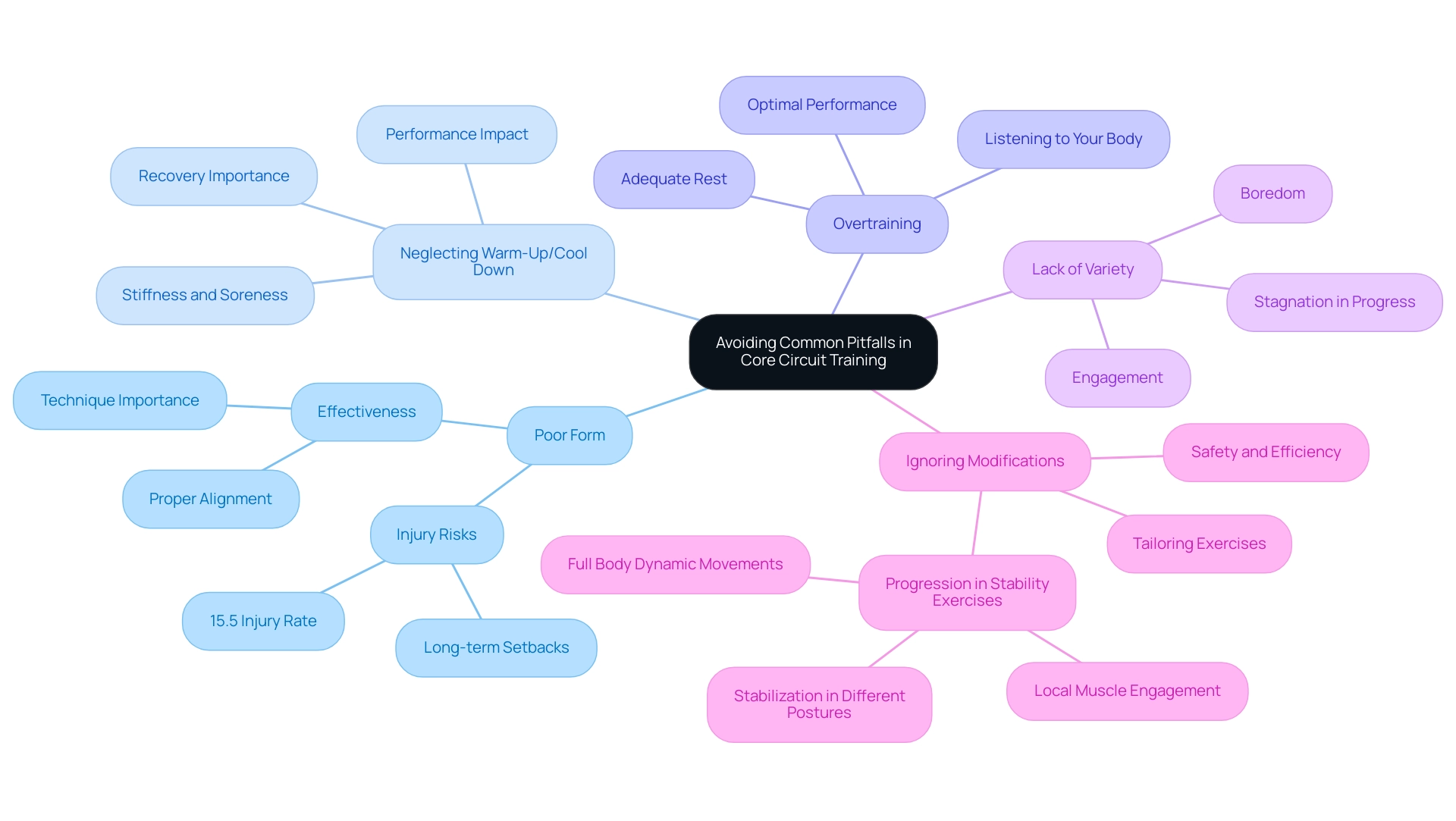
Modifying Your Core Circuit for All Fitness Levels
Designing a core workout circuit that accommodates all fitness levels is essential for fostering an inclusive environment. Here are effective modifications to consider:
- Beginner: For those just starting, simple activities such as seated leg lifts or modified planks performed on the knees can build foundational strength.
- Intermediate: Those with some experience can benefit from incorporating dynamic movements like bicycle crunches and Russian twists, which add variety and challenge.
- Advanced: To elevate intensity, consider adding weights or performing sophisticated movements such as hanging leg raises and stability ball passes, which significantly engage the abdominal muscles.
- Rest Intervals: Tailor rest intervals to match fitness levels; beginners may require longer breaks to recover, while advanced participants can handle shorter ones, keeping the momentum going.
- Progression: As strength increases, gradually ramp up the difficulty of your circuit. This approach not only promotes continuous improvement but also keeps participants motivated and engaged.
As noted by certified personal trainer Paige Waehner, "Inclusivity in fitness is essential for ensuring all individuals can benefit from exercise, fostering a supportive environment." By making these changes, you not only guarantee that every team member can engage but also assist them in gaining the significant advantages of fundamental development. A case study titled 'Isolated Core Conditioning' demonstrated that an 8-week program focused on isolated abdominal exercises without implements led to improvements in isometric flexor endurance, showcasing the effectiveness of customized abdominal routines.
Moreover, research by McGill & Marshall (2012) indicates that participating in a core workout circuit can significantly enhance overall physical performance, especially for individuals at varying fitness levels. Remember, inclusivity in fitness training leads to a more supportive and effective workout environment, ultimately enhancing overall team well-being.
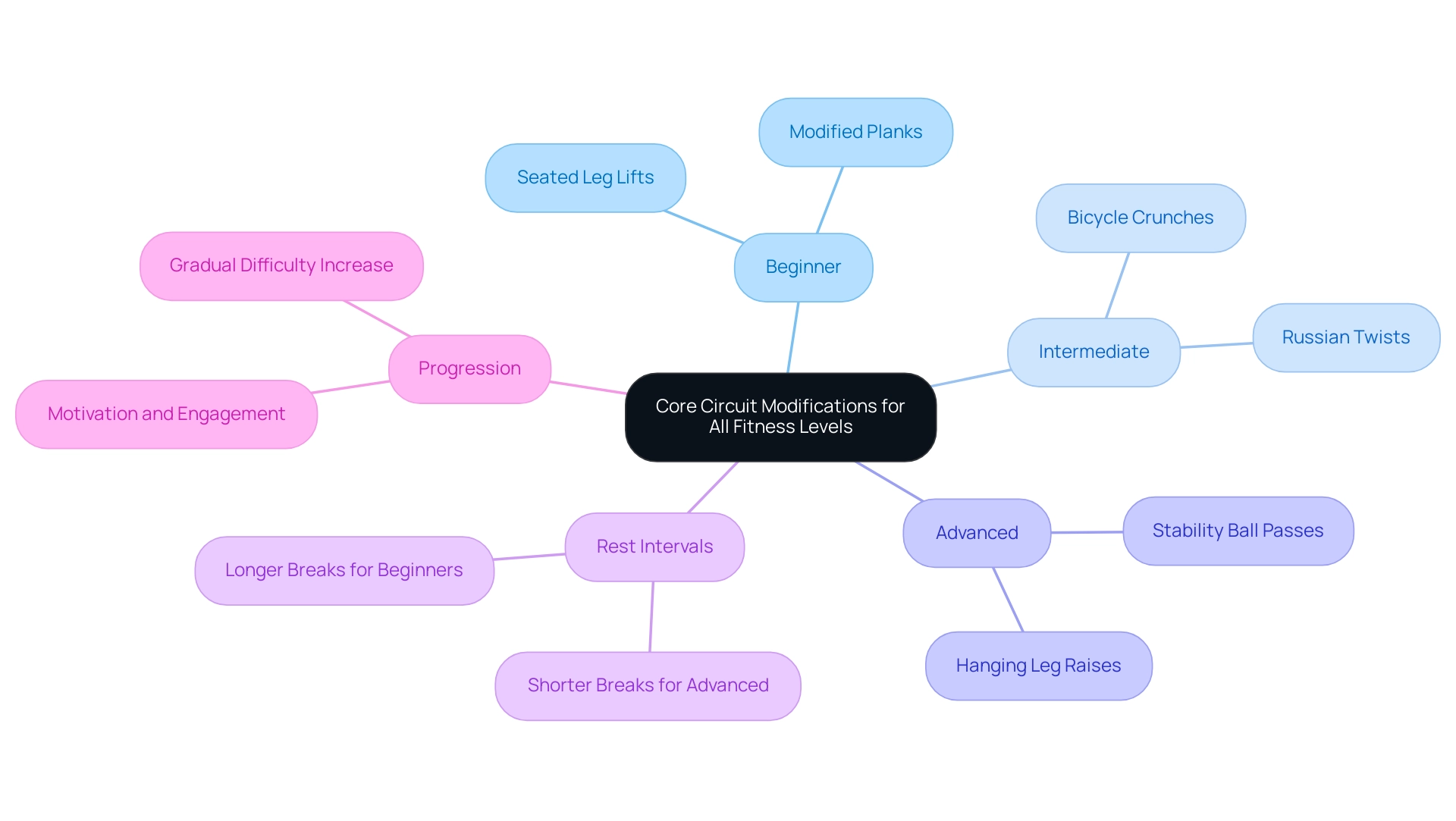
Conclusion
Incorporating core workouts into a workplace fitness routine is a strategic move towards enhancing both employee well-being and productivity. The benefits of circuit training stand out, offering a structured yet dynamic approach that engages participants while effectively building core strength. This not only improves physical fitness but also fosters essential qualities such as stability, endurance, and cardiovascular health.
By integrating essential exercises like:
- Planks
- Russian twists
- Bicycle crunches
into a well-structured circuit, individuals can experience significant gains in core strength and overall fitness. It is crucial to emphasize proper form and to avoid common pitfalls such as poor technique and overtraining, which can hinder progress and lead to injuries. Additionally, creating an inclusive environment by tailoring workouts to accommodate all fitness levels ensures that every team member can participate and thrive.
Ultimately, prioritizing core workouts fosters a culture of wellness that empowers teams to perform at their best. By embracing these strategies, organizations can cultivate a healthier, more dynamic workplace where employees are not only physically fit but also motivated to achieve their professional goals. Taking action today to implement these core training routines will yield lasting benefits for both individuals and the organization as a whole.
Frequently Asked Questions
Why are core workout circuits important for overall fitness and workplace productivity?
Core workout circuits boost overall fitness and well-being, particularly enhancing foundational strength, muscle endurance, stability, and cardiovascular health, which contribute to higher productivity levels at work.
What is circuit training, and how does it benefit fitness?
Circuit training involves performing a sequence of exercises that enhance muscle endurance and stability while elevating heart rates, significantly benefiting cardiovascular health.
What evidence supports the effectiveness of core exercises?
Research indicates a low risk of attrition and reporting bias in studies, lending credibility to essential exercises. For example, a study on semi-professional archers showed significant improvements in balance after 12 weeks of increased practice.
How can adding fundamental exercises to a routine impact stability and injury risk?
Incorporating fundamental exercises into a fitness routine can enhance stability, improve posture, and lower the likelihood of injury, all of which are crucial for maintaining high productivity levels at work.
What do experts say about the incorporation of core exercises into fitness regimens?
Experts, such as Shengyao Luo, emphasize that core exercises should be a regular part of athletes’ daily routines, highlighting their importance in any fitness regimen.
Who can benefit from core workout circuits?
The versatility of core workout circuits allows them to be tailored for all fitness levels, making them accessible and suitable for almost everyone.
What are some essential exercises to include in a core workout circuit?
Essential exercises include: 1. Plank: Hold for 30-60 seconds to enhance stability and strength. 2. Russian Twists: Perform 10-15 repetitions to work the obliques. 3. Bicycle Crunches: Do 15-20 reps to target multiple abdominal muscles. 4. Leg Raises: Execute 10-15 reps for lower abdominal strength. 5. Mountain Climbers: Alternate knees toward the chest for 30 seconds to boost cardiovascular endurance.
How long should a core workout circuit last for optimal results?
For optimal results, individuals should incorporate a variety of top-rated exercises into a daily core workout circuit lasting just five minutes.
What should be prioritized while performing core exercises?
Proper form and controlled movements should be prioritized to maximize effectiveness and prevent injury during core workouts.

